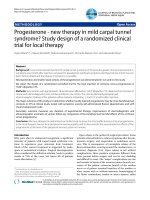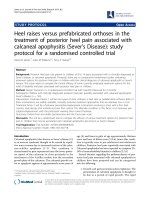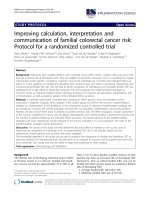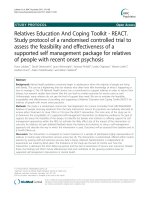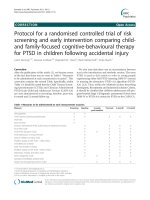Improving medication adherence with adjuvant aromatase inhibitor in women with breast cancer: Study protocol of a randomised controlled trial to evaluate the effect of short message service
Bạn đang xem bản rút gọn của tài liệu. Xem và tải ngay bản đầy đủ của tài liệu tại đây (827.76 KB, 9 trang )
He et al. BMC Cancer (2018) 18:727
/>
STUDY PROTOCOL
Open Access
Improving medication adherence with
adjuvant aromatase inhibitor in women
with breast cancer: study protocol of a
randomised controlled trial to evaluate the
effect of short message service (SMS)
reminder
Yunxin He1, Eng Hooi Tan1, Andrea Li Ann Wong2, Chuan Chien Tan3, Patrick Wong4, Soo Chin Lee2
and Bee Choo Tai1,5*
Abstract
Background: Medication adherence refers to whether a patient takes medication according to the frequency
prescribed, or continues to take a prescribed medication. Inadequate adherence to medication may cause
alterations in risk-benefit ratios, resulting in reduced benefits, increased risks or both, and is significantly associated
with adverse clinical outcomes and higher healthcare costs. We aim to examine the effect of a computer generated
short message service (SMS) reminder in improving medication adherence, and inhibiting the aromatisation process
amongst breast cancer women receiving oral aromatase inhibitor therapy.
Methods/Design: In this randomised controlled trial, eligible patients will be equally allocated to receive either
SMS reminder or standard care. The former receives weekly SMS reminder to take medication while the latter does
not receive any. The primary endpoint of medication adherence at 1-year is assessed using the Simplified
Medication Adherence Questionnaire, and compared using the χ2 test. Adjustment for baseline covariate and
potential confounders will be made using the logistic regression. Secondary outcomes involving estrone and
androstenedione levels will be compared using the analysis of covariance, whereas the estradiol levels (< 18.
4 pmol/L versus ≥18.4 pmol/L) will be compared using the χ2 test, and the logistic regression. Further, the
assessment of knowledge, attitude, behaviour, and barriers and facilitating factors of medication adherence will be
made via logistic regression.
(Continued on next page)
* Correspondence:
1
Saw Swee Hock School of Public Health, National University of Singapore
and National University Health System, 12 Science Drive 2, #10-03F,
Singapore 117549, Singapore
5
Yong Loo Lin School of Medicine, National University of Singapore and
National University Health System, 1E Kent Ridge Road, Singapore 119228,
Singapore
Full list of author information is available at the end of the article
© The Author(s). 2018 Open Access This article is distributed under the terms of the Creative Commons Attribution 4.0
International License ( which permits unrestricted use, distribution, and
reproduction in any medium, provided you give appropriate credit to the original author(s) and the source, provide a link to
the Creative Commons license, and indicate if changes were made. The Creative Commons Public Domain Dedication waiver
( applies to the data made available in this article, unless otherwise stated.
He et al. BMC Cancer (2018) 18:727
Page 2 of 9
(Continued from previous page)
Discussion: This will be the first study to evaluate short-term clinical outcomes from SMS reminder for breast
cancer patients on aromatase inhibitor therapy. Random allocation to SMS reminder or control arm ensures that
patients in both arms will be comparable with respect to demographic and clinical characteristics, and any
difference in outcomes can be attributed to the intervention. Participants are not blinded to the assignment of
intervention, thus there may be potential for bias in outcome assessments.
Trial registration: NCT02524548. Retrospectively registered on 17 August 2015.
Keywords: Randomised controlled trial, Aromatase inhibitor therapy, Breast cancer, Medication adherence, SMS
reminder
Background
Medication adherence typically refers to whether a patient
takes medication according to the frequency prescribed,
or continues to take a prescribed medication [1]. The
World Health Organisation defines medication adherence
to long-term therapy as “the extent to which a person’s
behaviour - taking medication, following a diet, and/or
executing lifestyle changes, corresponds with agreed recommendations from a health care provider” [2]. Accruing
evidences show that inadequate medication compliance
can cause alterations in benefit/risk ratios, resulting in
reduced benefits, increased risks or both [3, 4]. Medication non-adherence is significantly associated with adverse
clinical outcomes and higher healthcare costs [5].
Aromatase inhibitor and breast cancer risk and
recurrence
Breast cancer is the leading type of cancer affecting
women, and it was estimated that worldwide over
508,000 women died of this condition in 2011 [6]. In
Singapore, it is also the primary cause of death for
women from 2011 to 2015 [7]. Besides, a total of 9634
new cases of breast cancer were diagnosed in the same
period, accounting for 29.1% of incident cancers in
females and making it the most common cancer among
women [7].
Estrogen promotes the growth and survival of normal
and cancerous breast epithelial cells by binding and
activating the estrogen receptor (ER). The activated
receptor in turn binds to gene promoters in the nucleus
and activates many other genes responsible for cell
division, inhibition of cell death, new blood vessel formation and protease activity [8]. Thus, hormone therapy,
which is a form of systemic therapy, is recommended for
women with hormone receptor-positive breast cancer.
Aromatase inhibitor (AI), a commonly prescribed hormonal therapy for early stage breast cancer, interferes
with the body’s ability to produce estrogen from androgens by suppressing the aromatase enzyme activity.
Research has shown that women treated with adjuvant
hormone therapy for early-stage ER positive breast cancer gain at least 5 more years due to the treatment.
However, it has been reported that patients could suffer
from serious side effects of the hormone therapy [9].
Key et al. demonstrated a significant association between breast cancer risk and circulating estrogens in postmenopausal women [10]. Estrogen is the main stimulant
in the development and growth of breast cancer, [11] and
higher endogenous estrogen level has been found to be
associated with elevated breast cancer risk. Tamoxifen has
been successfully used for treating ER positive breast cancer for the past three decades. More recently, AI has been
demonstrated to provide a significant reduction in breast
cancer recurrence in post-menopausal women [4]. Following menopause, aromatase in fat and muscle may be
responsible for much of the circulating estrogen. In highly
estrogen-sensitive tissues such as the breast, uterus,
vagina, bone, brain, heart and blood vessels, it provides
local estrogen in an autocrine fashion. The aromatase
gene promoter in breast tissue is less sensitive than the
gene promoter in the ovary due to fluctuations in luteinising hormone but much more sensitive to increases in
inflammatory cytokines, which increases with age. In particular, breast tissue inflammatory cytokines increase with
proliferative breast disease and breast cancer [8].
A prospective, multi-centre, non-interventional study
reported significant improvements in long-term quality of
life of postmenopausal Chinese patients with hormonereceptor-positive early-stage breast cancer after starting
treatment with AI [12]. A recent meta-analysis also
showed the superiority of AI as an adjuvant hormonal
therapy in improving the disease-free and overall survival
of postmenopausal ER-positive breast cancer as compared
to tamoxifen [13]. In another clinical trial, researchers
have suggested that improvement in overall survival (hazard ratio 0.78; 95% CI 0.62 to 0.98) was seen among premenopausal women with the use of exemestane plus
ovarian suppression as compared to tamoxifen users [14].
However, adverse events include hot flushes, vaginal
dryness, loss of libido, fatigue, arthralgia, joint stiffness
and loss of bone mineral density with subsequent
increased risk of fracture [8, 15]. Also, as the treatment
of AI is long-term, medication adherence is an issue of
concern, with a proportion of women stopping before
He et al. BMC Cancer (2018) 18:727
completing the full treatment, while others not taking a
daily tablet regularly [16, 17]. Its adherence rate has been
shown to decline over time from 78 to 86% in the first year,
and reaching 62 to 79% by Year 3 [17]. A recent nested
case-control study showed that non-adherence to oral
endocrine therapy was significantly associated with worse
breast cancer survival (OR 4.07; 95% CI 3.27–5.06) [18].
Intervention to improve medication adherence
Recent reviews have shown that although various behavioural, educational, integrated care and self-management
risk communication interventions have been implemented to improve medication adherence, none of them
have shown promising impact [19, 20]. On the other
hand, studies have suggested that reminder of any form,
such as setting an alarm on a regular daily basis at home,
or have family reminding the patient to take medication,
have a positive influence on medication adherence in
cancer patients [19]. While healthcare institutions sometimes use short message service (SMS) to remind
patients of follow-up clinic appointments, mobile technology is seldom implemented to monitor medication
adherence until the recent decade [21]. This is a feasible
and acceptable form of managing medication which has
a high participant satisfaction [22]. Its use has been
shown to improve medication adherence in cardiovascular disease, diabetes, HIV, oral contraception, asthma, as
well as oncology patients with chronic conditions
[22, 23]. As mobile phone ownership continues to
increase, there is a great potential to utilise this technology to overcome adherence barriers and optimise
therapeutic effects [24].
Barriers and facilitating factors influencing medication
adherence
Malcolm et al. identified cost, side-effects, transportation, lack of reimbursement for the medication and inefficient patient-physician communication as barriers to
medication adherence [25]. Medication-taking behaviour
has been shown to be influenced by a patient’s belief and
his/her trust in the physician who prescribes the medication [26]. Also, non-adherence to endocrine therapy
might be due to patients’ response to the AI therapy and
its associated side effects such as arthralgia [27]. Besides,
it has been shown that nonadherence to medications for
chronic diseases prior to hormonal therapy was associated with more severe nonadherence to oral hormonal therapy in patients with breast cancer [28] A
cross-sectional study comprising mostly White women
showed that survivors who perceived that their pain
made taking AIs difficult or that the AI treatment
lasted too long were likely to be non-adherent, as
assessed by the Health Beliefs Scale Items and Scale Properties [29]. In contrast, a systematic review showed that
Page 3 of 9
taking more medications at baseline, referral to an oncologist, and being diagnosed at earlier times were positively
associated with adherence and/or persistence [16]. Thus,
in non-adherent patients, it is desirable to understand
their attitude and perception towards medication taking.
Cancer treatment adherence plays a crucial role in optimising health outcomes while medication non-adherence
is associated with decreased survival, higher recurrences
and increased healthcare costs. Hsieh et al. reported that
interruption and non-adherence to long-term adjuvant
hormone therapy was associated with increased mortality
in breast cancer women [30]. Treatment non-adherence
to adjuvant hormonal therapy was found to be associated
with increased all-cause mortality amongst Asian
breast cancer women. Moreover, a greater impact of
non-adherence on mortality was especially found in
the younger breast cancer population [30].
Implementing innovative technology to tackle the
problem of non-adherence and understanding its barriers will provide scientific evidence for clinical decision
making and improve health outcomes. We thus propose
to examine the effect of a computer automated SMS
reminder in improving medication adherence amongst
breast cancer women receiving oral AI therapy.
Study objectives
The primary objective is to evaluate whether SMS
reminder improves medication adherence as compared
to standard care (control) amongst breast cancer women
who have been receiving adjuvant endocrine therapy for
at least 1 year, and are continuing to receive adjuvant AI
therapy for at least 1 more year.
The secondary objectives are to examine whether SMS
reminder improves the inhibition of aromatisation
process of patients receiving AI therapy. We postulate
that at 1-year, there will be
– Lower estrone and estradiol levels in the SMS
reminder group as compared to the control.
– Higher androstenedione level in the SMS reminder
group as compared to the control.
Tertiary objectives include
– Assessing the impact of SMS reminder on the
improvement in knowledge, attitude and behaviour
towards medication compliance.
– Identifying barriers and facilitating factors for
medication adherence.
Methods/Design
Study design
This is an open-label, multi-centre prospective randomised controlled trial of SMS reminder versus standard
He et al. BMC Cancer (2018) 18:727
care to investigate whether SMS reminder improves adherence to oral AI therapy in breast cancer women at
1-year follow-up. A total of 280 breast cancer women
will be recruited from the National University Cancer
Institute, Singapore and the Ng Teng Fong General
Hospital, Singapore. Eligible participants will receive
financial compensation for each study visit in an amount
within the guidelines of the ethics review board.
Inclusion criteria
– Women who have been receiving adjuvant
endocrine therapy for at least 1 year, and are
continuing to receive adjuvant AI therapy for at
least 1 more year.
– Aged 21 to 80 years.
– Have cellular phone that can receive text messages.
– Singaporean or permanent resident who is currently
residing in Singapore.
– Able to give informed consent.
Exclusion criteria
– Unable or not willing to comply with study
procedures.
Page 4 of 9
Randomisation procedure
All eligible patients who have provided informed consent
will be randomised to receive either SMS reminder or
standard care in a 1:1 ratio. Balanced permuted block
randomisation will be implemented with varying block
sizes, stratified by centre. Allocation concealment will be
ensured, as the randomisation allocation, generated by
the responsible statistician, will not be released to the
research coordinator until the patient has been recruited
into the trial by means of a central telephone call upon
meeting the eligibility criteria. The study flow chart is
shown in Fig. 2.
Data collection
Three questionnaires will be administered via face-to-face
interview by the Research coordinator. The Simplified
Medication Adherence Questionnaire (SMAQ) is a validated 6-item questionnaire which measures adherence
[32]. Non-compliance is defined if a patient responds to
any of items 1 to 4 with a non-adherence answer; and if
the patient has skipped more than two doses during the
last week or has not taken medication for more than two
complete days during the last visit. In addition, information on knowledge, attitude and behaviour towards medication taking will be elicited via the Beliefs about
Medicines Questionnaire (BMQ) [33] and the Adherence
Starts with Knowledge (ASK-12) questionnaire [34].
Follow-up and assessments
Study intervention
A systematic review involving HIV patients found
weekly reminders to significantly improve the percentage
of achieving 90% adherence, while daily reminders
showed no improvement [31]. Thus, we propose to send
weekly SMS reminders on the first working day of each
week, that is, at 9:00 AM each Monday morning from a
tablet via an automated messaging system, throughout
the 1-year follow-up period for the intervention group.
A screen shot of the message sent is shown in Fig. 1.
The message includes information on patient’s name,
date, hospital, medication and frequency of oral AI therapy. In order to cater to the multi-ethnic study population, the message is translated to Mandarin or Malay. If
a patient is not proficient in English, the messages will
be sent using her preferred language. The control group
will not receive any message. Regardless of the randomised allocation, all patients will be given a log for the
next 6 months to record whether they have received the
message (for the intervention group) or taken the pills
according to instruction. The log will be recalled on the
subsequent visit and a new log will be distributed to
patients for recording the information for the subsequent 6 months. This log will be returned to the study
coordinator at the end of the study.
The assessments and follow-up schedule (with a window
period of ±2 months) are summarised in Table 1.
Fig. 1 SMS reminder from the automated messaging system
He et al. BMC Cancer (2018) 18:727
Page 5 of 9
The patients will be followed up half yearly. The
SMAQ will be administered at each visit, while the
BMQ and ASK-12 questionnaires will be administered at
baseline and 1-year. The hormone assays of estrone,
estradiol and androstenedione will also be performed at
baseline and 1-year.
This trial does not involve any experimental treatment
and thus poses no additional risks to patients. Nevertheless, at each follow-up visit, the research coordinator will
record any symptom or event that a patient may have
experienced that is considered as UPIRTSO (Unanticipated Problems Involving Risks to Subjects and
Others) event. These events will be monitored closely
using a log book.
Statistical considerations
Sample size
The sample size is estimated based on the primary endpoint of medication adherence (as measured via SMAQ)
at 1-year. Assuming that the proportion of medication
adherence in the intervention and control groups are 80
and 60% respectively, [17] then based on a 5% significance level and a power of 90%, a minimum sample of
240 subjects (i.e. 120 per group) will be required.
Further assuming an attrition rate of 10%, the overall
trial size is 280.
Statistical analysis plan
The assessment of medication adherence at 1-year
between the SMS reminder and control groups will be
made using the χ2 test, with adjustment for potential
confounders made using the logistic regression.
Natural log transformation will be implemented on
the estrone and androstenedione measures to normalise
the data. The comparison of secondary outcomes involving estrone and androstenedione levels will be made
using the analysis of covariance (ANCOVA) to adjust for
the respective baseline levels and other potential confounders. The estradiol levels (defined as < 18.4 pmol/L
versus ≥18.4 pmol/L) will be compared between the two
arms using the χ2 test and the logistic regression analysis
will be implemented to adjust for baseline covariate and
other potential confounders where appropriate.
The assessment of knowledge, attitude, behaviour, as
well as barrier and facilitating factors between the intervention and control groups will be made using χ2 tests,
with treatment effect quantified based on odds ratio
estimate and its 95% confidence interval. Further
adjustment for baseline scores and other potential
confounders will be made using the logistic regression
analysis where appropriate.
All analyses will be performed according to the
principle of intention-to-treat using STATA version 15,
assuming a two-sided test at the 5% level of significance.
Assessing medication adherence
There are different ways of assessing medication compliance. Patient self-reporting relies mainly on a patient’s
recall, and is susceptible to bias. Pill count has also been
shown to be unreliable especially if patients fail to return
the bottles or dumped the pills before the count [35].
Medication possession ratio is commonly used for
claims-based adherence measurement. However, it overestimates the true adherence rate particularly when a
patient receives an early refill of the medication. The
proportion of days covered (PDC), a recent method for
calculating adherence, avoids double counting when
refills overlap or when oversupply of medication exists
[36]. However, it ignores instances when patients refill
their prescriptions before finishing the drug.
In a further sub-study, we will compare the four different measures of adherence, to determine which of these
provide a more meaningful or reliable information in the
local context based on different performance indicators
Table 1 Summary of study procedures and schedule
Study procedures
Visit 1
Visit 2
Visit 3
Screening/Baseline
Month 6
Month 12
x
x
Informed consent
x
Assess eligibility
x
SMAQ
x
BMQ, ASK-12
x
Prescription data
x
Pill count and refill data
Estrone, estradiol and androstenedione assays
Patient log of daily pill taken and weekly SMS
Check receipt of SMS
a
x
x
x
x
x
x
x
UPIRTSO event
a
x
x
Research coordinator will verbally check the status of SMS receipt at each clinic visit
x
x
x
x
x
He et al. BMC Cancer (2018) 18:727
Page 6 of 9
Fig. 2 Study flow chart
such as the sensitivity, specificity and kappa statistics
using PDC as the gold standard. The percentages of
adherence between the different measures will be compared via the McNemar’s test.
Ethics and dissemination
Informed consent will be obtained by the co-Principal
Investigators or research coordinator during the screening visit, prior to randomisation into the trial. The
patient’s consent to participate in the trial should be
obtained after a full explanation has been given of the
intervention options and the manner of intervention
allocation. A copy of the signed consent form with study
information will be given to the patients for their retention. The right of the patient to refuse to participate
without giving reasons must be respected. After the
patient has entered the trial, the clinician must remain
free to give alternative intervention to that specified in
the protocol at any stage if she feels it to be in the
patient’s best interest. The patient must remain free to
withdraw at any time from the protocol intervention
without giving reasons and without prejudicing her
further treatment.
The protocol and the associated informed consent
documents have been reviewed and approved by the
institutional review board of both study sites. The results of this trial will be published in a peer-reviewed
journal.
Data quality assurance
To ensure accuracy, completeness and reliability, the
data will be prospectively collected and entered into the
electronic database. Hardcopies of the data collection
forms will be checked for completeness and verified by
the research coordinator before data entry. Validity
range checks will also be built into the database. At the
study closure, 10% of the records will be randomly sampled for data quality assurance.
He et al. BMC Cancer (2018) 18:727
Confidentiality of data and patient records
All data will be treated with strict confidentiality and will
not be shared with parties other than members of the
investigating team. All data will be centrally coordinated
and the hardcopy forms will be kept under lock-and-key
in a cabinet in the research coordinator’s office. The
softcopy data will be stored in a hard disk and protected
by password. Subjects will be identified by a unique trial
number and their identities will not be revealed in the
data collection forms or questionnaires. A patient study
ID list containing patient’s name, personal identification
number, mobile phone number and trial number will be
maintained and kept in a study folder separate from the
data collection forms.
Discussion
In recent years, various interventions have been utilised
to improve medication adherence to AI therapy for
breast or other types of cancer [37, 38]. A pilot randomised controlled trial of a web-enabled application to
provide real-time monitoring and better management of
treatment-related adverse symptoms among patients
with hormone-receptor positive breast cancer showed
web-enabled application with weekly reminders
significantly improved short-term AI adherence. Also,
several studies have suggested that short message
reminder could benefit adherence to breast selfexamination or cancer-screening among breast cancer
patients [39, 40]. Chung et al. suggested that
self-reported breast self-examination (BSE) adherence
and the frequency of BSE were significantly higher in
the intervention group than in the control group in
the 6-month period [39]. However, to our knowledge,
there has not been any study involving short-term
clinical outcomes such as hormonal assays from
reminders for breast cancer patients on AI therapies.
Studies on breast cancer have demonstrated that
patients commonly reported suffering from physical and
psychological inconvenience due to AI therapies [41]. As
compared to women without a history of cancer, breast
cancer patients, reported significantly higher odds of
new onset of forgetfulness, difficulty in concentrating,
hair loss and numbness or tingling in the extremities
after the first 6 months of AI therapy, with odds ratio
ranging between 2 to 4 folds [41]. A German study also
showed that age contributed to the difference in medication adherence amongst breast cancer women who were
treated with AI [42]. It suggested that patients aged over
70 years exhibited a 25% reduction in risk of treatment
discontinuation as compared to younger patients. However, a literature review discussing poor adherence with
hormonal therapy among women with breast cancer
disagreed with the notion that non-adherence could be
due to older age (≥55 years). It reported that other
Page 7 of 9
reasons for hormonal therapy non-adherence could be
due to patient’s behaviour, treatment toxicity, cost of
health care or medications, and comorbidities [43]. Also,
it has been further suggested that medication compliance may be improved if financial barriers were removed
[43]. Meanwhile, other researchers have identified
socio-demographic and clinical characteristics to be
associated with medication beliefs about AI such as concern, perceived necessity of taking the drug to improve
one’s health, and cancer/health worry amongst postmenopausal women [44].
This trial has several strengths as well as limitations.
This will be the first study to evaluate short-term clinical
outcomes from SMS reminder for breast cancer patients
on AI therapy. Random allocation to SMS reminder or
control arm ensures that patients in both arms will be
comparable with respect to demographic and clinical
characteristics, and any difference in outcomes can be
attributed to the intervention. However, participants are
not blinded to the assignment of intervention, thus there
may be potential for bias in outcome assessments.
In short, sending SMS reminder to early-stage breast
cancer women could be an added feature to existing
healthcare protocol for breast cancer women if the
results from our trial are promising. Understanding the
potential barriers to medication adherence would
enable policy makers to make informed decision when
promoting regulations to minimise the impact of the
barriers while formulating policies to elevate medication adherence.
Abbreviations
AI: Aromatase inhibitor; ANCOVA: Analysis of covariance; ASK: Adherence
Starts with Knowledge; BMQ: Beliefs about Medicines Questionnaire;
BSE: Breast self-examination; ER: Estrogen receptor; NCIS: National University
Cancer Institute, Singapore; PDC: Proportion of days covered;
SMAQ: Simplified Medication Adherence Questionnaire; SMS: Short message
service; UPIRTSO: Unanticipated problems involving risks to subjects and
others
Acknowledgements
The authors would like to thank the oncologists, nursing staff, research
coordinators and patients at the participating sites for their contribution.
Funding
This trial is supported by the Singapore Cancer Society Cancer Research
Grant 2014; National University Cancer Institute, Singapore (NCIS) Centre
Grant Seed Funding Program (Aug 2014 Grant Call); National University
Health System Bridging Funds FY17. These funding sources had no role in
the design of this study and will not have any role during its execution,
analysis, interpretation of the data, or decision to submit results.
Authors’ contributions
AW, CCT, PW, SCL and BCT participated in the design of the study and
research protocol. EHT and YXH will coordinate the study, and are
responsible for data acquisition. EHT, YXH and BCT will conduct statistical
analysis. YXH, EHT, AW, CCT, PW, SCL and BCT were involved in the writing,
editing, and approval of the final manuscript. All authors have read and
approved the final manuscript.
He et al. BMC Cancer (2018) 18:727
Ethics approval and consent to participate
The protocol (version 5, dated 24 April 2015) and the associated informed
consent documents have been reviewed and approved by the National
Healthcare Group Domain Specific Review Board on 4 May 2015, under the
reference number DSRB 2014/01316. Protocol amendments, if any, will be
reviewed and approved by the DSRB and documented in a memorandum.
Written informed consent will be obtained from participants in this study.
Consent for publication
Not applicable.
Competing interests
The authors declare that they have no competing interests.
Publisher’s Note
Springer Nature remains neutral with regard to jurisdictional claims in
published maps and institutional affiliations.
Author details
1
Saw Swee Hock School of Public Health, National University of Singapore
and National University Health System, 12 Science Drive 2, #10-03F,
Singapore 117549, Singapore. 2Department of Haematology-Oncology,
National University Cancer Institute, NUHS Tower Block Level 7, 1E Kent
Ridge Road, Singapore 119228, Singapore. 3Department of General Surgery,
Ng Teng Fong General Hospital, 1 Jurong East Street 21, Singapore 609606,
Singapore. 4Division of Oncology Pharmacy, National University Cancer
Institute, NUHS Tower Block Level 7, 1E Kent Ridge Road, Singapore 119228,
Singapore. 5Yong Loo Lin School of Medicine, National University of
Singapore and National University Health System, 1E Kent Ridge Road,
Singapore 119228, Singapore.
Received: 7 February 2018 Accepted: 4 July 2018
References
1. Delamater AM. Improving patient adherence. Clinical Diabetes. 2006;24:71–7.
2. Sabaté E. Adherence to long-term therapies : evidence for action. Geneva:
World Health Organization; 2003. />42682/1/9241545992.pdf. Accessed 1 Jan 2018
3. DiMatteo MR, Giordani PJ, Lepper HS, Croghan TW. Patient adherence and
medical treatment outcomes: a meta-analysis. Med Care. 2002;40(9):794–811.
4. Howell A, Cuzick J, Baum M, Buzdar A, Dowsett M, Forbes JF, Hoctin-Boes G,
Houghton J, Locker G, Tobias J. Results of the ATAC (Arimidex, tamoxifen,
alone or in combination) trial after completion of 5 years’ adjuvant
treatment for breast cancer. Lancet. 2005;365(9453):60–2.
5. Ho PM, Bryson CL, Rumsfeld JS. Medication adherence: its importance in
cardiovascular outcomes. Circulation. 2009;119(23):3028–35.
6. World Health Organization. Breast cancer: prevention and control. 2017
/>Accessed 1 Jan 2018.
7. National Registry of Diseases Office. Singapore Cancer Registry Annual
Registry Report. 2017. />Publications-Cancer/cancer-registry-annual-report-2015_web.pdf?sfvrsn=10.
Accessed 18 Nov 2017.
8. Fabian CJ. The what, why and how of aromatase inhibitors: hormonal
agents for treatment and prevention of breast cancer. Int J Clin Pract. 2007;
61(12):2051–63.
9. Partridge AH, LaFountain A, Mayer E, Taylor BS, Winer E, Asnis-Alibozek A.
Adherence to initial adjuvant anastrozole therapy among women with
early-stage breast cancer. J Clin Oncol. 2008;26:556–62.
10. Key T, Appleby P, Barnes I, Reeves G. Endogenous sex hormones and breast
cancer in postmenopausal women: reanalysis of nine prospective studies. J
Natl Cancer Inst. 2002;94(8):606–16.
11. Johnston SR, Dowsett M. Aromatase inhibitors for breast cancer: lessons
from the laboratory. Nat Rev Cancer. 2003;3(11):821–31.
12. Cao A, Zhang J, Liu X, Wu W, Liu Y, Fan Z, Zhang A, Zhou T, Fu P, Wang S,
et al. Health-related quality of life of postmenopausal Chinese women with
hormone receptor-positive early breast cancer during treatment with
adjuvant aromatase inhibitors: a prospective, multicenter, non-interventional
study. Health Qual Life Outcomes. 2016;14:51.
Page 8 of 9
13. Ryden L, Heibert Arnlind M, Vitols S, Hoistad M, Ahlgren J. Aromatase
inhibitors alone or sequentially combined with tamoxifen in
postmenopausal early breast cancer compared with tamoxifen or placebo meta-analyses on efficacy and adverse events based on randomized clinical
trials. Breast. 2016;26:106–14.
14. Francis PA, Regan MM, Fleming GF, Láng I, Ciruelos E, Bellet M, Bonnefoi HR,
Climent MA, Da Prada GA, Burstein HJ. Adjuvant ovarian suppression in
premenopausal breast cancer. N Engl J Med. 2015;372(5):436–46.
15. Breastcancer.org. Aromatase Inhibitors. 2017. />treatment/hormonal/aromatase_inhibitors. Accessed 20 Jan 2018.
16. Murphy CC, Bartholomew LK, Carpentier MY, Bluethmann SM, Vernon SW.
Adherence to adjuvant hormonal therapy among breast cancer survivors in
clinical practice: a systematic review. Breast Cancer Res Treat. 2012;134(2):
459–78.
17. Verma S, Madarnas Y, Sehdev S, Martin G, Bajcar J. Patient adherence to
aromatase inhibitor treatment in the adjuvant setting. Curr Oncol. 2011;
18(Suppl 1):S3–9.
18. Valachis A, Garmo H, Weinman J, Fredriksson I, Ahlgren J, Sund M,
Holmberg L. Effect of selective serotonin reuptake inhibitors use on
endocrine therapy adherence and breast cancer mortality: a populationbased study. Breast Cancer Res Treat. 2016;159(2):293–303.
19. Costa E, Giardini A, Savin M, Menditto E, Lehane E, Laosa O, Pecorelli S,
Monaco A, Marengoni A. Interventional tools to improve medication
adherence: review of literature. Patient Prefer Adherence. 2015;9:1303–14.
20. Greer JA, Amoyal N, Nisotel L, Fishbein JN, MacDonald J, Stagl J, Lennes I,
Temel JS, Safren SA, Pirl WF. A systematic review of adherence to oral
antineoplastic therapies. Oncologist. 2016;21(3):354–76.
21. Australia and New Zealand Horizon Scanning Network. Horizon Scanning
Technology Prioritising Summary- The use of SMS text messaging to
improve outpatient attendance. 2007. />internet/horizon/publishing.nsf/Content/
6B81AEB3E7EE0001CA2575AD0080F344/$File/
May%20Vol%2016%20No%201%20-%20SMS.pdf. Accessed 1 Jan 2018.
22. Park LG, Howie-Esquivel J, Dracup K. A quantitative systematic review of the
efficacy of mobile phone interventions to improve medication adherence. J
Adv Nurs. 2014;70(9):1932–53.
23. Matthews K. Improving medication adherence for oncology patients
through high-tech. Interventions. 2015; https://www.
specialtypharmacytimes.com/publications/specialty-pharmacy-times/2015/
june-2015/improving-medication-adherence-for-oncology-patients-throughhigh-tech-interventions. Accessed 8 Jan 2018
24. Hanauer DA, Wentzell K, Laffel N, Laffel LM. Computerized automated
reminder diabetes system (CARDS): E-mail and SMS cell phone text
messaging reminders to support diabetes management. Diabetes Technol
Ther. 2009;11(2):99–106.
25. Malcolm SE, Ng JJ, Rosen RK, Stone VE. An examination of HIV/AIDS patients
who have excellent adherence to HAART. AIDS Care. 2003;15(2):251–61.
26. Molfenter TD, Bhattacharya A, Gustafson DH. The roles of past behavior and
health beliefs in predicting medication adherence to a statin regimen.
Patient Prefer Adherence. 2012;6:643–51.
27. Yang GS, Kim HJ, Griffith KA, Zhu S, Dorsey SG, Renn CL. Interventions for
the treatment of aromatase inhibitor-associated arthralgia in breast cancer
survivors: a systematic review and meta-analysis. Cancer Nurs. 2017;40(4):
E26–41.
28. Neugut AI, Zhong X, Wright JD, Accordino M, Yang J, Hershman DL.
Nonadherence to medications for chronic conditions and nonadherence to
adjuvant hormonal therapy in women with breast cancer. JAMA Oncol.
2016;2(10):1326–32.
29. Bright EE, Petrie KJ, Partridge AH, Stanton AL. Barriers to and facilitative
processes of endocrine therapy adherence among women with breast
cancer. Breast Cancer Res Treat. 2016;158(2):243–51.
30. Hsieh K-P, Chen L-C, Cheung K-L, Chang C-S, Yang Y-H. Interruption and
non-adherence to long-term adjuvant hormone therapy is associated with
adverse survival outcome of breast cancer women-an Asian populationbased study. PLoS One. 2014;9(2):e87027.
31. Vervloet M, Linn AJ, van Weert JC, De Bakker DH, Bouvy ML, Van Dijk L. The
effectiveness of interventions using electronic reminders to improve
adherence to chronic medication: a systematic review of the literature. J
Am Med Inform Assoc. 2012;19(5):696–704.
32. Ortega Suárez FJ, Sánchez Plumed J, Pérez Valentín MA, Pereira Palomo P,
Muñoz Cepeda MA, Lorenzo Aguiar D. Validation on the simplified
He et al. BMC Cancer (2018) 18:727
33.
34.
35.
36.
37.
38.
39.
40.
41.
42.
43.
44.
medication adherence questionnaire (SMAQ) in renal transplant patients on
tacrolimus. Nefrologia. 2011;31(6):690–6.
Horne R, Weinman J, Hankins M. The beliefs about medicines questionnaire:
the development and evaluation of a new method for assessing the
cognitive representation of medication. Psychol Health. 1999;14:1–24.
Matza LS, Park J, Coyne KS, Skinner EP, Malley KG, Wolever RQ. Derivation
and validation of the ASK-12 adherence barrier survey. Ann Pharmacother.
2009;43(10):1621–30.
Garfield S, Clifford S, Eliasson L, Barber N, Willson A. Suitability of measures
of self-reported medication adherence for routine clinical use : a systematic
review. BMC Med Res Methodol. 2011;11:149.
Nau DP. Proportion of days covered (PDC) as a preferred method of
measuring medication adherence. Springfield, VA: Pharmacy Quality
Alliance; 2012. />PQA%20PDC%20vs%20%20MPR.pdf. Accessed 22 Aug 2014
Graetz I, McKillop CN, Stepanski EJ, Vidal GA, Lee SS. Use of a web-based
app to improve breast cancer symptom management and aromatase
inhibitor adherence. J Clin Oncol. 2017;35(Suppl 5):89.
Fishbein JN, Nisotel LE, MacDonald JJ, Amoyal Pensak N, Jacobs JM,
Flanagan C, Jethwani K, Greer JA. Mobile application to promote adherence
to oral chemotherapy and symptom management: a protocol for design
and development. JMIR Res Protoc. 2017;6(4):e62.
Chung IY, Kang E, Yom CK, Kim D, Sun Y, Hwang Y, Jang JY, Kim SW. Effect
of short message service as a reminder on breast self-examination in breast
cancer patients: a randomized controlled trial. J Telemed Telecare. 2015;
21(3):144–50.
Vidal C, Garcia M, Benito L, Milà N, Binefa G, Moreno V. Use of text-message
reminders to improve participation in a population-based breast Cancer
screening program. J Med Syst. 2014;38(9):118.
Gallicchio L, Calhoun C, Helzlsouer K. A prospective study of aromatase
inhibitor therapy initiation and self-reported side effects. Support Care
Cancer. 2017;25(9):2697–705.
Jacob L, Hadji P, Kostev K. Age-related differences in persistence in women
with breast cancer treated with tamoxifen or aromatase inhibitors in
Germany. J Geriatr Oncol. 2016;7(3):169–75.
Hershman DL. Sticking to it: improving outcomes by increasing adherence.
J Clin Oncol. 2016;34(21):2440–2.
Salgado TM, Davis EJ, Farris KB, Fawaz S, Batra P, Henry NL. Identifying
socio-demographic and clinical characteristics associated with medication
beliefs about aromatase inhibitors among postmenopausal women with
breast cancer. Breast Cancer Res Treat. 2017;163(2):311–9.
Page 9 of 9
